Monthly economic brief: December 2020
The monthly economic brief provides a summary of latest key economic statistics, forecasts and analysis on the Scottish economy.
This document is part of a collection
Labour Market
Unemployment remained low by historical standards in October, supported by the Job Retention Scheme, however wider labour market indicators signal challenging labour market conditions.
Coronavirus Jobs Retention Scheme (CJRS) and Self Employment Income Support Scheme[11]
- The CJRS has been supporting the retention of jobs and incomes since March, during the national lockdown phase, as restrictions were relaxed in the third quarter, and has been extended to the end of April 2021 in the expectation that restrictions on economic activity will continue into next year.
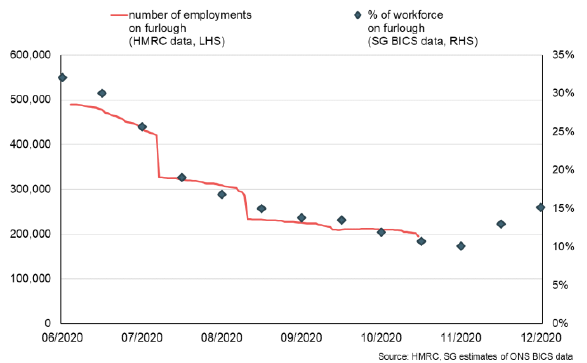
- At the end of October, 195,200 employments (8%) in Scotland were on furlough. This is down from 421,200 (17%) at the end of July and from 216,500 (9%) at the end of September, reflecting the restarting of many business and subsequent return to work for people over this period. Furthermore, at the end of October, 56% of employments were on full furlough, with 44% on partial furlough, reflecting the flexibility on staffing levels that businesses needed as they resumed operations, though with many operating below capacity and with ongoing cashflow challenges.
- More recent Scottish Government ONS BICS data for the start of December continues to show both the breadth of support that the scheme provides across the economy and its rising take-up as regional restrictions have been introduced. At the start of December, an estimated 51% of businesses in Scotland had staff on furlough (up from 49% in October/November), supporting 15% of the workforce (up from 10% in October/November).[12]
- The Self Employed Income Support Scheme (SEISS) has also continued to provide critical support to the labour market. HMRC data show that by end of October, 142,000 claims in Scotland had been made to the second SEISS which opened on 17 August. This represents 67% of the eligible population, with an average claim of £2,500. By that point, 161,000 individuals had claimed for either the first or second SEISS, with 86% of those claiming both grants.
Official labour market statistics
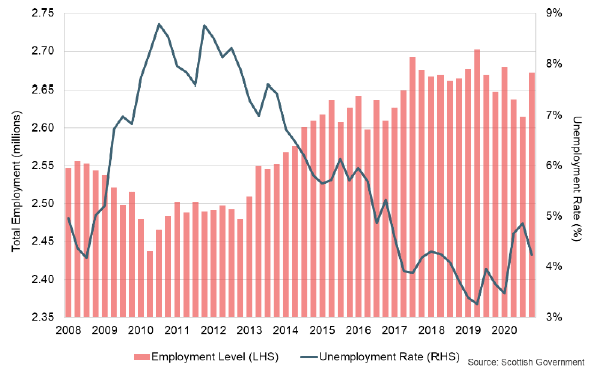
- The latest labour market statistics cover the period August to October when national lockdown restrictions were eased, but regional restrictions started to be introduced in October and businesses continued to receive support through the CJRS and SEISS.
- Over the quarter to August to October 2020,[13] the employment level increased by 57,000 in Scotland and the employment rate increased by 1.4 percentage points to 74.8% (UK: 75.2%). The unemployment level fell by 15,000 over the quarter and the unemployment rate fell 0.6 percentage points to 4.2% (UK: 4.9%).
- The improvement in employment over the quarter is partly reflected in a decrease in economic inactivity (those neither in employment or ILO unemployed), with the level falling by 33,000 and the inactivity rate decreasing by 0.9 percentage points to 21.8% (UK: 20.8%).
- The headline labour market indicators only show a partial picture of the labour market as people on furlough are considered employed. Wider labour market indicators show challenges that have been emerging in the labour market during the pandemic.
PAYE payrolled employment
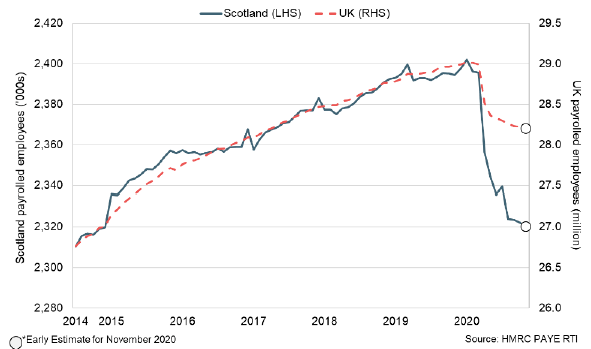
- The more timely Pay As You Earn (PAYE) Real Time Information data show that the number of payrolled employees in Scotland and the UK as a whole has fallen sharply in 2020.
- In November, the number of payrolled employees fell 3.1% (74,000) over the year (UK: -2.7%) to 2.32 million, with most of the fall occurring since March as the pandemic and economic restrictions started to impact the economy directly.[14]
Claimant Count
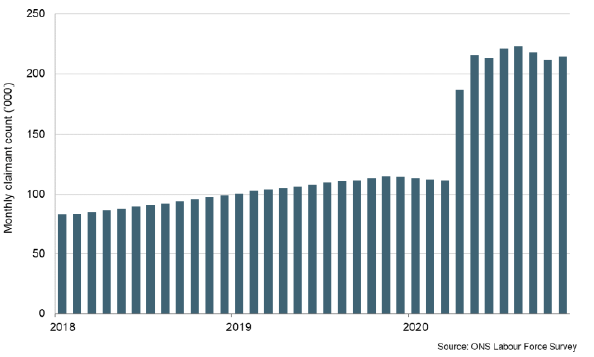
- Scotland’s Claimant Count (the number of claimants of Job Seekers Allowance and claimants of Universal Credit claiming principally for the reason of being unemployed) remains significantly higher in November than at the start of the year, signalling that the number of people that are unemployed or employed with low income and/or low hours has increased.[15]
- In November, there were 214,200 claimants, up 1.1% over the month and up 92% since March.
Demand for staff in Scotland
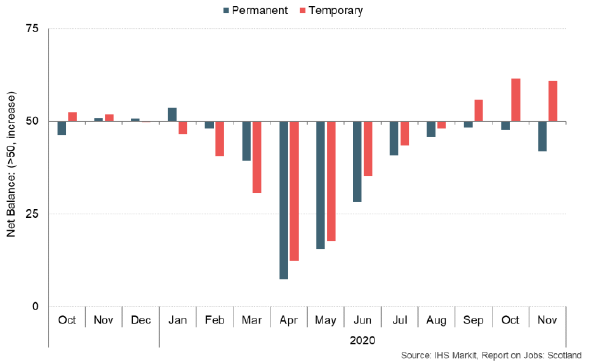
- The IHS Markit RBS Report on Jobs survey for November showed a mixed picture for recruitment activity with a sharp fall in permanent job placements and a further increase in temporary placements.[16]
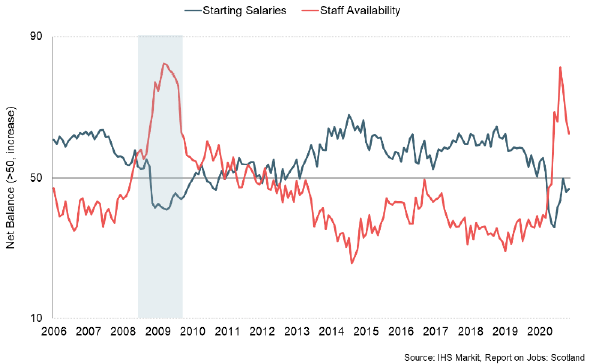
- Permanent job placements fell for a third consecutive month in November and at their sharpest rate since July. In contrast, temporary job placements increased for the third month, likely reflecting businesses choosing to suspend permanent hires in favour of more flexible recruitment through temporary staff amid the current restrictions.
- While hiring activity remained subdued, staff availability (labour supply) continued to increase in November, though at its slowest pace since May, with respondents continuing to link the increase in staff availability to job losses and redundancies. Alongside this, starting salaries in Scotland declined in November for both permanent and temporary staff, however the overall pace of decline slowed from October.
Earnings
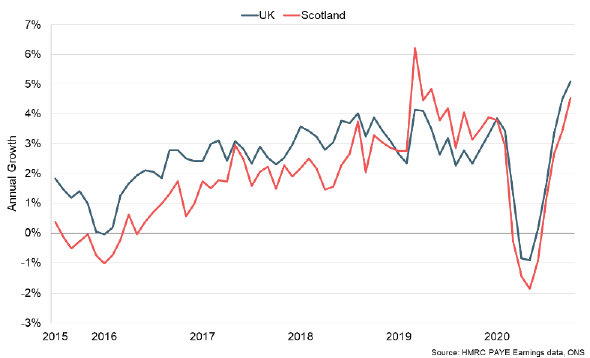
- More broadly on earnings, despite the protection offered to the labour market through the furlough scheme, earnings fell at the beginning of the pandemic. Between March and June, PAYE mean monthly pay fell for four consecutive months compared to the previous year. It returned to growth in July, and having strengthened for four months, in October, PAYE mean monthly pay in Scotland was £2,438, up 4.5% compared to October 2019. (UK: 5.1%).[17]
- While the mean annual earnings growth rate has rebounded sharply in 2020, the picture is complex and there are likely to be compositional effects (e.g. by sector and across income levels) underlying the data which would suggest that not all parts of the labour market will have experienced the same rebound as the mean rate implies.
Contact
Email: OCEABusiness@gov.scot
There is a problem
Thanks for your feedback